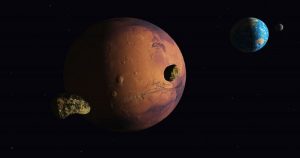
Two Out Of Four Newly Discovered Planets Are Inhabitable
With the boundlessly growing population and pollution, it is quite clear that we human being s must start hunting for the more land and resources. Started with the common dream of expediting Mars, the red planet. We ended up with various theories stating the possibilities of life on Saturn’s moon Titan.
However, the recent studies proved that Titan is not as suitable as we thought, nor the Proxima B which later became the much-anticipated topic.
Well, there is no end to our curiosity, now, scientists have discovered two potentially habitable planets which are been orbiting a relatively nearby star “Tau Ceti” which almost looks like our Sun. Out of these four Earth-sized worlds, two of them thought to be in the so-called habitable zone – a distance from the star where liquid water could survive on the surface.

This Sun-like star is situated 12 light years from the sun, reasonably close in astronomical terms, and is very similar in size and brightness to our star. The discovery was made by an international group of astronomers, led by the University of Hertfordshire in the United Kingdom.
This discovery of the planets was made when weak wobbles were detected in the movement of tau Ceti caused by the planets. The team used the HARPS spectrograph of the European Southern Observatory in Chile and the Keck-HIRES instrument in Mauna Kea in Hawaii.
As of now, these four planets are considered as one of those discovered nearest the sun-like stars. Scientists will now use other methods to try to figure out whether the surface of the planets is rocky and suitable for existence.
“We’re getting tantalizingly close to observing the correct limits required for detecting Earth-like planets, our detection of such weak wobbles is a milestone in the search for earth analogs and the understanding of the earth’s habitability by comparison with these,” said Dr. Fabo Feng, a research fellow at the University of Hertfordshire and lead researcher on the study.
Related Article: New Storm On Neptune Makes Earth-Sized Appearance